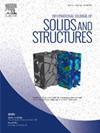A rheological constitutive model to predict the anisotropic biaxial bending behavior of spiral strands subjected to variable axial force
IF 3.4
3区 工程技术
Q1 MECHANICS
International Journal of Solids and Structures
Pub Date : 2024-09-24
DOI:10.1016/j.ijsolstr.2024.113082
引用次数: 0
Abstract
Spiral strands exhibit dissipative bending behavior when subjected to external axial force. To the best of the authors’ knowledge, only the uniaxial bending behavior of spiral strands subjected to constant axial force has been studied in the literature so far. Thanks to a recently developed mixed stress–strain driven computational homogenization for spiral strands, this paper is the first to study the biaxial bending behavior of spiral strands subjected to variable tensile force. Based on the observed anisotropic behavior, a rheological constitutive model equivalent to multilayer spiral strands is proposed to predict their behavior under such loading. For an -layer strand, the proposed model consists of several angularly distributed uniaxial spring systems, referred to as a multiaxial spring system, where each uniaxial spring system consists of a spring and slider-springs. In a uniaxial spring system, the spring represents the slip contribution of all wires to the bending stiffness of the strand, while each slider-spring represents the stick contribution of each layer. A major advantage of the proposed scheme is its straightforward parameter identification, requiring only several monotonic uniaxial bendings under constant axial force. The proposed rheological model has been verified against the responses obtained from the mixed stress–strain driven computational homogenization through several numerical examples. These examples consist of complex uniaxial and biaxial load cases with variable tensile force. It has been shown that the proposed scheme not only predicts the response of the strand, but also provides helpful insight into the complex underlying mechanism of spiral strands. Furthermore, the low computational cost of the proposed models makes them perfect candidates for implementation as a constitutive law in a beam model. Using a single beam with the proposed constitutive law, spiral strand simulations can be performed in a few seconds on a laptop instead of a few hours or days on a supercomputer.
预测螺旋股在可变轴向力作用下的各向异性双轴弯曲行为的流变构成模型
螺旋股在受到外部轴向力时表现出耗散弯曲行为。据作者所知,迄今为止,文献中只研究了螺旋绞线在恒定轴向力作用下的单轴弯曲行为。得益于最近开发的螺旋钢绞线混合应力-应变驱动计算均质化技术,本文首次研究了螺旋钢绞线在可变拉力作用下的双轴弯曲行为。基于观察到的各向异性行为,本文提出了一个等效于多层螺旋绞线的流变构成模型,以预测其在此类载荷下的行为。对于 Nl 层螺旋绞线,提出的模型由多个角度分布的单轴弹簧系统组成,称为多轴弹簧系统,其中每个单轴弹簧系统由一个弹簧和 Nl 个滑块弹簧组成。在单轴弹簧系统中,弹簧代表所有导线对钢绞线弯曲刚度的滑移贡献,而每个滑块弹簧则代表每层的棍棒贡献。所提方案的一个主要优点是参数识别简单,只需在恒定轴力下进行几次单调的单轴弯曲即可。通过几个数值示例,根据混合应力-应变驱动计算均质化得到的响应,对所提出的流变模型进行了验证。这些示例包括具有可变拉力的复杂单轴和双轴载荷情况。结果表明,所提出的方案不仅能预测钢绞线的响应,还能帮助人们深入了解螺旋钢绞线复杂的内在机理。此外,所提模型的计算成本较低,因此非常适合作为梁模型的构成法则。使用带有所提出的构成法则的单梁,螺旋绞线模拟可以在笔记本电脑上几秒钟内完成,而不需要在超级计算机上花费几小时或几天的时间。
本文章由计算机程序翻译,如有差异,请以英文原文为准。
求助全文
约1分钟内获得全文
求助全文
来源期刊
CiteScore
6.70
自引率
8.30%
发文量
405
审稿时长
70 days
期刊介绍:
The International Journal of Solids and Structures has as its objective the publication and dissemination of original research in Mechanics of Solids and Structures as a field of Applied Science and Engineering. It fosters thus the exchange of ideas among workers in different parts of the world and also among workers who emphasize different aspects of the foundations and applications of the field.
Standing as it does at the cross-roads of Materials Science, Life Sciences, Mathematics, Physics and Engineering Design, the Mechanics of Solids and Structures is experiencing considerable growth as a result of recent technological advances. The Journal, by providing an international medium of communication, is encouraging this growth and is encompassing all aspects of the field from the more classical problems of structural analysis to mechanics of solids continually interacting with other media and including fracture, flow, wave propagation, heat transfer, thermal effects in solids, optimum design methods, model analysis, structural topology and numerical techniques. Interest extends to both inorganic and organic solids and structures.

 求助内容:
求助内容: 应助结果提醒方式:
应助结果提醒方式:


